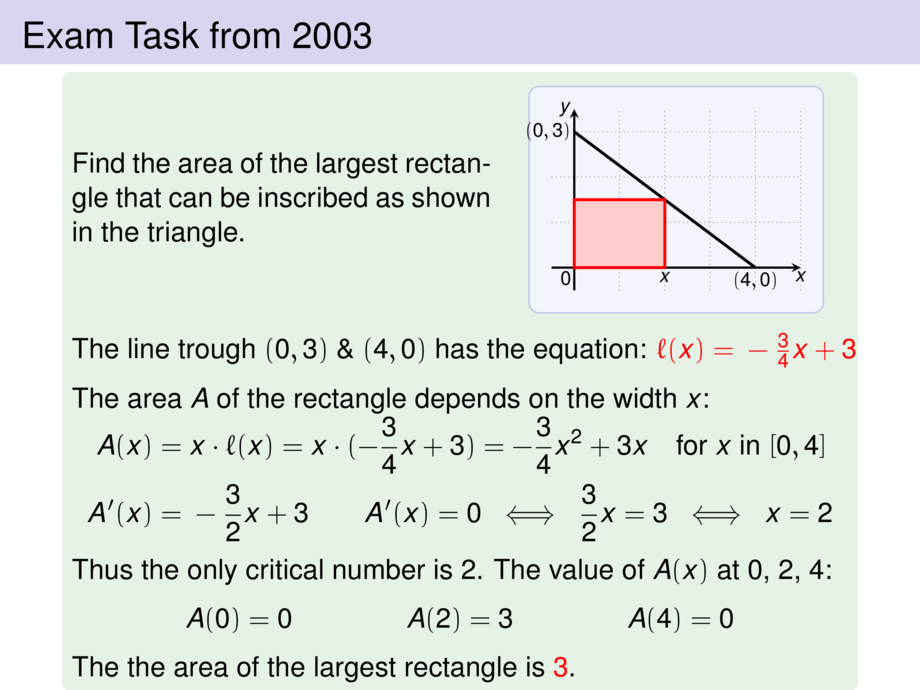



































































































209/209
\begin{frame}
\frametitle{Exam Task from 2003}
\vspace{-1ex}
\begin{exampleblock}{}
\begin{minipage}{.54\textwidth}
Find the area of the largest rectangle that can be inscribed as shown
in the triangle.
\end{minipage}
\begin{minipage}{.45\textwidth}
\begin{center}
\scalebox{.7}{
\begin{tikzpicture}[default,baseline=1cm,scale=.9]
\diagram{-.5}{5}{-.5}{3.5}{1}
\diagramannotatez
\begin{scope}[ultra thick]
%\draw plot[smooth,domain=-.5:4,samples=30] function{ (x**3 - 3*x**2 + 1)/5};
\draw[black] (0,3) -- node[at start,left] {$(0,3)$} node[at end,below] {$(4,0)$} (4,0);
\draw[cred,fill=cred!20] (0,0) rectangle (2,1.5);
\mpause[1]{ \node[below] at (2,0) {$x$}; }
\end{scope}
\end{tikzpicture}
}
\end{center}
\end{minipage}
\pause\smallskip
The line trough $(0,3)$ \& $(4,0)$ has the equation:
\alert{$\ell(x) = \pause -\frac{3}{4}x + 3$}\hspace{-2ex}
\pause\medskip
The area $A$ of the rectangle depends on the width $x$:\vspace{-1ex}
\begin{talign}
A(x) &= \mpause[1]{x \cdot \ell(x)} \mpause[2]{ = x \cdot (-\frac{3}{4}x + 3)}
\mpause[3]{ = -\frac{3}{4}x^2 + 3x}
\quad \mpause[4]{\text{for $x$ in $[\mpause[5]{0},\mpause[5]{4}]$}}
\\
\mpause[6]{A'(x) }&\mpause[7]{= }\mpause[8]{-\frac{3}{2}x + 3}
\quad\quad \mpause[9]{A'(x) =0 \;\iff\;}\mpause[10]{\frac{3}{2}x = 3}\mpause[11]{\;\iff\; x = 2}
\end{talign}
\pause\pause\pause\pause\pause\pause\pause\pause\pause\pause\pause\pause
Thus the only critical number is $2$.
The value of $A(x)$ at $0$, $2$, $4$:
\begin{talign}
A(0) = \mpause[1]{0}
&& \mpause[2]{A(2) =} \mpause[3]{3}
&& \mpause[4]{A(4) =} \mpause[5]{0}
\end{talign}
\pause\pause\pause\pause\pause\pause
The the area of the largest rectangle is \alert{$3$}.
\end{exampleblock}
\end{frame}

